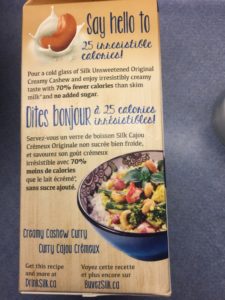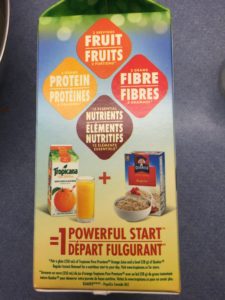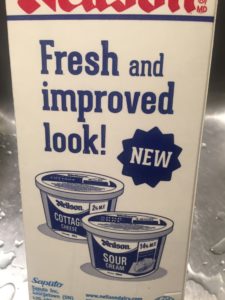Consider the two-litre beverage carton. There’s a pointy top that has either too much glue at the end you’re supposed to open or a plastic spout with a twist off lid. There’s the bottom we don’t look at and then there are the four sides. Some people see a product label, a list of ingredients and some nutrition information. I see a conversation.
A Conversation About Cashews
 In the case of the cashew milk carton on the right, the conversation goes something like this:
In the case of the cashew milk carton on the right, the conversation goes something like this:
Me: Hmm. Cashew milk. That’s new. I wonder how you milk a cashew. What would I possibly do with this?
Package: You can use cashew milk as you would cow milk and coconut milk.
Me: Cool, but my fridge is crowded enough; I don’t need a second kind of milk.
Package: But it’s got fewer calories.
Me: Good point. I’m worried it will be a disappointing watery nasty thing.
Package: It’s creamy and you won’t know the difference. Plus, you can go online and get more recipes for things that aren’t disappointing.
This is a pretty good conversation to be having at the store or even in someone’s kitchen. Even though the package misses a fantastic opportunity to help me out with the mental picture I have of milking a cashew it addresses some key barriers to purchase. By acknowledging that cashew milk is a new product, this panel opens up a conversation about how and why to choose it over other products and suggests uses the consumer may not have considered.
A Positioning of Porridge
Let’s see what the orange juice is trying to tell me.
Me: Hello, orange juice. Looks like you’ve got plenty of fibre, protein and nutrients.
Package: I’ve got two servings of fruit! Fruit’s good.
Me: But on the other side, it says you have no fibre and just 2 grams of protein.
Package: Why don’t you go ahead and get some instant porridge.
Me: Plus of the 12 essential nutrients listed here, I only see four on the other side of this package.
Package: What part of cross-selling don’t you understand, lady? Buy the damn porridge, don’t buy the damn porridge. I don’t care. But don’t blame me if you’re not regular.
This is not the best conversation ever because it’s rooted in a deception at the top of the panel. Now I’m all for a well-timed cross-sell, but this is a little skeezy. I think this panel would work just as well if the little image and the equation at the bottom were right up at the top so we are all telling the full truth from the beginning.
The Milk Carton Monologue
Package: We’ve redesigned the cottage cheese and sour cream containers.
Me: Oh.
Really? The marketers behind this milk could find no better use of this space? That’s the best they could come up with? Thousands and thousands of these cartons are being handled multiple times every day by their customers and the thing they wanted more than anything in the world for that customer to do or think or know is that the cottage cheese package may look different. Fresher, even. Sigh.
We talk a lot in this space about the need to align our sales and marketing teams, and how that is difficult and so on. What these three examples help us understand is the need to align marketing with product management. And soon.
The cashew milk people seem to have that one nailed. The panel does a great job of communicating (in two languages, no less) the key benefits of the product, along with some ways to use it that might not be obvious.
The orange juice panel is what happens when you leave marketers alone too long. Product managers, would, one hopes, know better.
And the milk carton is a stunning example of what happens when product managers sneak one past marketing and use their inside voice in public.
Next week we’ll look at other reasons marketers need to spend a lot more time with product management.
Related Posts
The Furry Dead Things at the Unimpressed Feet of Sales
All Together Now: Blame Marketing
BizMarketer is written by Elizabeth Williams
I help companies have better conversations
Drop me a line at ewilliams@candlerchase.com
Leave a Reply
You must be logged in to post a comment.